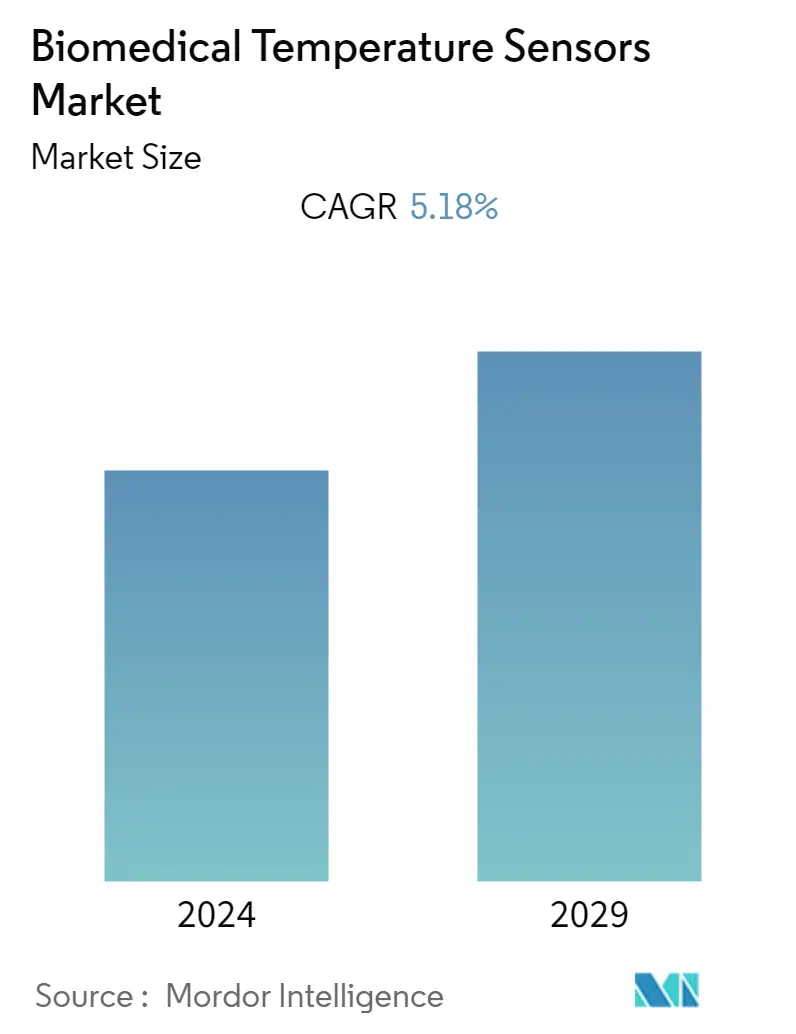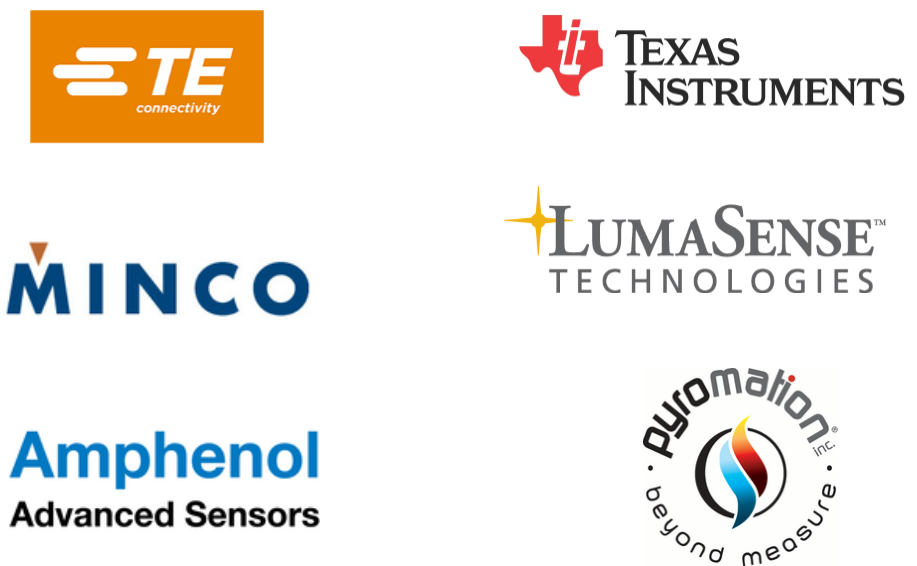Market Size of Biomedical Temperature Sensors Industry

| Study Period | 2019 - 2029 |
| Base Year For Estimation | 2023 |
| CAGR | 5.18 % |
| Fastest Growing Market | Asia Pacific |
| Largest Market | North America |
| Market Concentration | Low |
Major Players
*Disclaimer: Major Players sorted in no particular order |
Biomedical Temperature Sensors Market Analysis
The biomedical temperature sensors market was valued at USD 6.17 billion in 2020, and it is expected to reach a value of USD 8.36 billion by 2026, projecting a CAGR of 5.18% during the forecast period (2021-2026). The growing applications of different temperature sensors in the biomedical sector are expected to contribute to the market's growth positively, during the forecast period.
- Over the past few years, the demand for biomedical temperature sensors has been increasing, along with rising application in the healthcare sector. This is due to an increase in investment by government to have safe and reliable healthcare infrastructure in place.
- Temperature sensors are critical in the healthcare industry, as they are used in painless or anesthesia-driven surgeries, life-supporting machines, dialysis of failed kidneys, analyzing blood information, oxygen temperature measurement for life support systems, temperature monitoring for neonatal and patients in critical care, digital temperature measurement, organ transplants monitoring, and many more sub-optimal surgeries.
- Temperature sensors can be used for measuring not only temperature, but also a number of other physical parameters. They are often applied in calorimetric flow sensors, i.e., for measuring blood or respiratory airflow. Skin blood flow (SBF) or skin perfusion is a complex phenomenon that occurs in capillaries.
- For instance, fiberoptic temperature sensors have found valuable application in numerous areas of research and treatment in biology and medicine. These include tissue monitoring during electromagnetic heating for cancer therapy, catheter-tip sensors as part of multi-purpose fiberoptic probes, patient monitoring during magnetic resonance imaging (MRI), and microwave biohazards studies.
Biomedical Temperature Sensors Industry Segmentation
There are different types of temperature sensors: thermocouples, thermistors, resistance temperature detectors (RTDs), liquid crystal temperature sensors, fiber optic sensors, and infrared sensors.
| By Type | |
| Thermocouples | |
| Thermistors | |
| Resistance Temperature Detectors (RTDs) | |
| Liquid Crystal Temperature Sensors | |
| Fibre Optic Sensors | |
| Infrared Sensors |
| Geography | |
| North America | |
| Europe | |
| Asia-Pacific | |
| Rest of the World |
Biomedical Temperature Sensors Market Size Summary
The biomedical temperature sensors market is experiencing significant growth, driven by their increasing applications in the healthcare sector. These sensors are essential for various medical procedures, including painless surgeries, life-support systems, and critical care monitoring. The demand for these sensors is bolstered by government investments aimed at enhancing healthcare infrastructure, ensuring safe and reliable medical services. The integration of temperature sensors in advanced medical technologies, such as fiber optic probes, is expanding their use in research and treatment, including cancer therapy and patient monitoring during MRI scans. The adoption of Internet of Things (IoT) applications in healthcare is further propelling the market, as these sensors enable rapid and accurate health diagnostics.
Regionally, North America is poised for substantial growth due to the increasing need for medical services and the focus on developing high-value medical equipment. The stringent government regulations and the expanding healthcare sector in this region are expected to drive market expansion. The market is characterized by high competitive rivalry, with opportunities arising from technological innovations and collaborations between established companies and startups. Key players in the market, such as TE Connectivity and Amphenol Advanced Sensors, are actively enhancing their product offerings to meet the rising demand for reliable and accurate biomedical temperature sensors.
Biomedical Temperature Sensors Market Size - Table of Contents
-
1. MARKET DYNAMICS
-
1.1 Market Overview
-
1.2 Introduction to Market Drivers and Restraints
-
1.3 Market Drivers
-
1.3.1 Increasing Spending on Diagnostics
-
1.3.2 Growing Demand for Fitness Devices
-
1.3.3 Increasing Health Concerns
-
-
1.4 Market Restraints
-
1.4.1 Complexities in Fabrication and High Costs
-
-
1.5 Industry Attractiveness - Porter's Five Forces Analysis
-
1.5.1 Threat of New Entrants
-
1.5.2 Bargaining Power of Buyers/Consumers
-
1.5.3 Bargaining Power of Suppliers
-
1.5.4 Threat of Substitute Products
-
1.5.5 Intensity of Competitive Rivalry
-
-
1.6 Technology Snapshot
-
-
2. MARKET SEGMENTATION
-
2.1 By Type
-
2.1.1 Thermocouples
-
2.1.2 Thermistors
-
2.1.3 Resistance Temperature Detectors (RTDs)
-
2.1.4 Liquid Crystal Temperature Sensors
-
2.1.5 Fibre Optic Sensors
-
2.1.6 Infrared Sensors
-
-
2.2 Geography
-
2.2.1 North America
-
2.2.2 Europe
-
2.2.3 Asia-Pacific
-
2.2.4 Rest of the World
-
-
Biomedical Temperature Sensors Market Size FAQs
What is the current Biomedical Temperature Sensors Market size?
The Biomedical Temperature Sensors Market is projected to register a CAGR of 5.18% during the forecast period (2024-2029)
Who are the key players in Biomedical Temperature Sensors Market?
TE Connectivity Ltd, Amphenol Advanced Sensors, Texas Instruments Incorporated, Minco Products Inc. and Smiths Medical Inc. are the major companies operating in the Biomedical Temperature Sensors Market.

